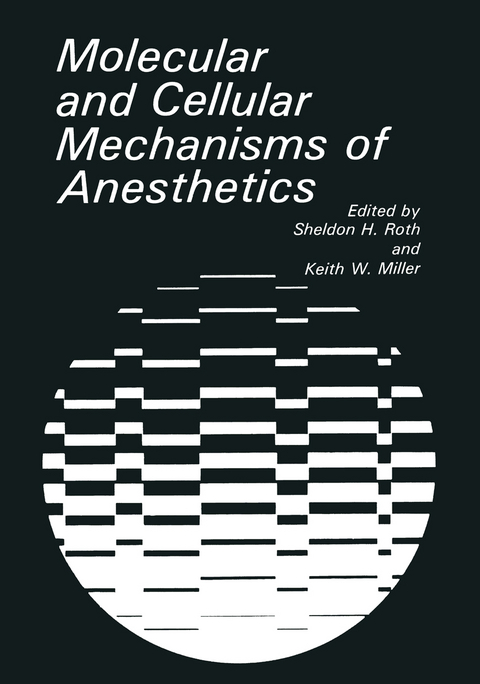
Molecular and Cellular Mechanisms of Anesthetics
Springer-Verlag New York Inc.
978-1-4684-5035-4 (ISBN)
B. Raymond Fink Sheldon Roth and Keith Miller have asked me to record that the Third Conference on Molecular and Cellular Mechanisms of Anesthesia was held in Calgary last May "in my honor. " Such was my dear friends' gracious way of continuing a series that began at the University of Washington, where I hosted two, four, or five previous ones, 1,3-6 depending 2 on how far back one wishes to count. At that, Seattle took up where Paris left off in 1951. These occasions create their own unforgettable memories. This book captures the fine, invigorating ambience of the University of Calgary and the exciting explorations and com panionship of a gathering in a frontier territory of neuroscience. So, floreant symposia. They have progressively refined the quarry, from pathway to synapse to lipoprotein membrane to receptor and single channel, in heuristic convergences of neuronal physiology, biochemistry, and pharmacology. Nevertheless, the anesthesiologist in me senses a certain disquiet, a certain claustrophobia provoked by the narrow confines of micropipettes. How much more tubular must tunnel vision become before the desired broad view emerges? At present, the advances in molecular neurobiology seem continually to increase the apparent complexity of the total problem and the conceptual distance between the reductionists in the laboratories and the holists in the operating rooms. Happily, what is also growing is the excitement in trying to bridge the gap. Perhaps it would be timely to regard general anesthesia not as a state but as a syndrome.
I. Cellular Actions of Anesthetics.- 1. Cellular and Synaptic Effects of General Anesthetics.- 2. Barbiturate and Benzodiazepine Actions on Mouse Neurons in Cell Culture.- 3. Postsynaptic Actions of Pentobarbital in Cultured Mouse Spinal Neurons and Rat Hippocampal Neurons.- 4. Selective and Differential Effects of Barbiturates on Neuronal Activity.- 5. Putative Capacitance Increase in Hippocampal CAl Cells following Ethanol Application.- 6. General Anesthetics and Intracellular Free Calcium Ions.- 7. Actions of Local Anesthetics on Identified Leech Neurons.- 8. Effects of Isoflurane on some Passive and Active Electrical Properties of Trigeminal Sensory Neuronsin Vivo.- II. Postsynaptic Actions of Anesthetics.- 9. An Approach to Anesthetic Action from Studies of Acetylcholine Receptor Function.- 10. Interactions of Local Anesthetics with Torpedo Nicotinic Acetylcholine Receptors.- 11. General Anesthetics Act Both Specifically and Nonspecifically on Acetylcholine Receptors.- 12. The Influence of Anesthetics on Postsynaptic Ion Channels.- 13. Mechanism of Nicotinic Channel Blockade by Anesthetics.- 14. Barbiturate Enhancement of ?-Aminobutyric Acid Receptor Binding and Function as a Mechanism of Anesthesia.- 15. Barbiturate-Sensitive Sites in the Benzodiazepine-GABA Receptor-Ionophore Complex.- III. Anesthetics and Sodium Channels.- 16. An Overview of the Mechanisms of Local Anesthetic Action Past, Present, and Future.- 17. Lidocaine Block of Sodium Channels in Heart Cells.- 18. The Kinetic Basis for Phasic Local Anesthetic Blockade of Neuronal Sodium Channels.- 19. Single-Channel Analysis of the Action of Na Channel Blockers 9-Aminoacridine and QX-314 in Neuroblastoma Cells.- 20. Inhibition of Voltage-Sensitive Sodium Channels by Local Anesthetics and Anticonvulsants: ABiochemical and Electrophysiological Analysis.- IV. Biophysical Mechanisms of Anesthetics.- 21. Inside the “Black Box”.- 22. The Action of Nonionic Anesthetic Substances on Voltage-Gated Ion Conductances in Squid Giant Axons.- 23. Solubility of Volatile Hydrocarbons in Lipid Bilayers: A New Perspective.- 24. The Influence of Anesthetics on the Structure and Thermal Properties of Saturated Lecithins.- 25. Molecular Details of Anesthetic-Lipid Interaction as Seen by Nuclear Magnetic Resonance.- 26. Do Direct Protein/Anesthetic Interactions Underlie the Mechanism of General Anesthesia?.- V. Pressure-Anesthetic Interactions.- 27. Homogeneous and Branching Axons: Differing Responses to Anesthetics and Pressure.- 28. New Observations on the Mechanism of Pressure-Anesthetic Interactions.- 29. Modification of Pressure and Anesthesia Tolerance by Multiday Exposures to High-Pressure Heliox or to Subanesthetic Levels of General Anesthetics.- 30. Pressure Reversal of Halothane’s Antiviral Action: Effect of Halothane and Pressure on Measles Vims Protein Synthesis.- VI Toxicity of Local Anesthetics.- 31. Potentially Toxic Actions of Local Anesthetics in Cardiac Tissue.- 32. Modulated Receptor Theory and Cardiac Toxicity of Local Anesthetics.- 33. Toxicity of Intravenously Administered Local Anesthetic Agents in the Dog: Cardiovascular and Central Nervous System Effects.- 34. Local Anesthetic Effects on Myocardial Excitation-Contraction Coupling.- VII Toxicity of General Anesthetics.- 35. Anesthetic-Induced Hepatotoxicity in the Hyperthyroid Rat.- 36. Role of Oxygen Availability to the Liver in Anesthesia-Induced Hepatotoxicity.- 37. Pathogenic Mechanisms for Halothane Hepatotoxicity in Animal Models and Man.- 38. Evidence for a Role in the Immune System in the Pathogenesis ofHalothane Hepatitis.- Appendix: Tables of Physical and Pharmacological Properties of Anesthetics.- Contributors.
| Erscheint lt. Verlag | 30.3.2012 |
|---|---|
| Zusatzinfo | 70 Illustrations, black and white; XII, 502 p. 70 illus. |
| Verlagsort | New York, NY |
| Sprache | englisch |
| Maße | 178 x 254 mm |
| Themenwelt | Medizin / Pharmazie ► Medizinische Fachgebiete ► Anästhesie |
| Medizin / Pharmazie ► Medizinische Fachgebiete ► Chirurgie | |
| Medizin / Pharmazie ► Medizinische Fachgebiete ► Pharmakologie / Pharmakotherapie | |
| Medizin / Pharmazie ► Pharmazie | |
| Naturwissenschaften ► Biologie ► Biochemie | |
| Naturwissenschaften ► Biologie ► Zoologie | |
| Naturwissenschaften ► Physik / Astronomie ► Angewandte Physik | |
| ISBN-10 | 1-4684-5035-2 / 1468450352 |
| ISBN-13 | 978-1-4684-5035-4 / 9781468450354 |
| Zustand | Neuware |
| Haben Sie eine Frage zum Produkt? |
aus dem Bereich


